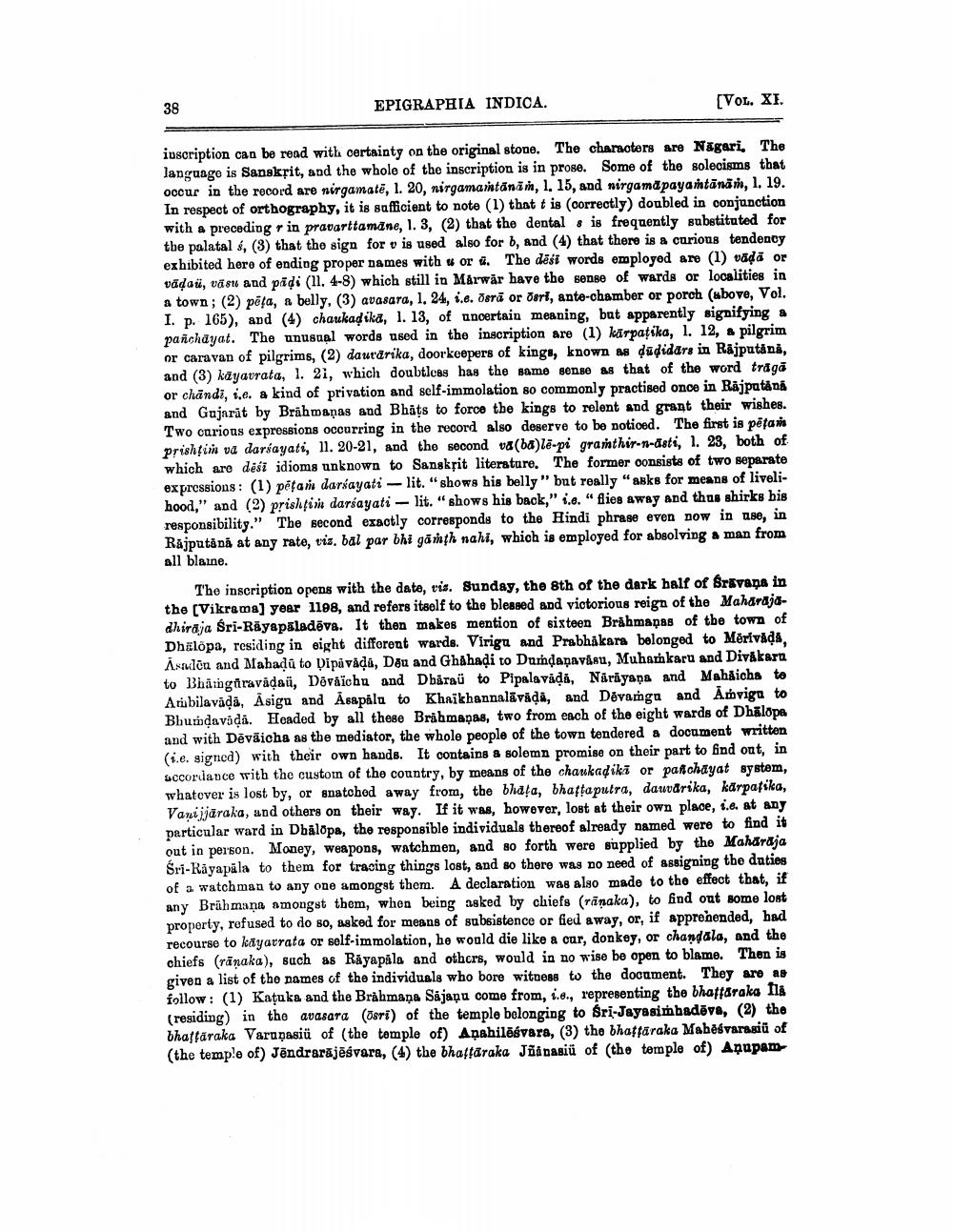________________
EPIGRAPHIA INDICA.
[VOL. XI.
inscription can be read with certainty on the original stone. The characters are Nagari, The language is Sanskrit, and the whole of the inscription is in prose. Some of the solecisms that occur in the record are nirgamatë, 1. 20, nirgamantanin, 1. 15, and nirgamd payantānā n, l. 19. In respect of orthography, it is sufficient to note (1) that t is correctly) doubled in conjunction with a preceding rin pravarttamane, 1.3, (2) that the dental , is frequently substituted for the palatal $, (3) that the sign for v is used also for b, and (4) that there is a curious tendency exhibited here of ending proper names with # or . The desi words employed are (1) vādā or vädaü, västs and padi (11. 4-8) which still in Mårwar have the sense of wards or localities in a town; (2) pēta, a belly, (3) avasara, 1. 24, i.e. Osrā or deri, ante-chamber or porch (above, Vol. I. p. 165), and (4) chaukadíka, 1. 13, of uncertain meaning, but apparently signifying a panchayat. The unusual words used in the inscription are (1) kārpaţika, l. 12, & pilgrim or caravan of pilgrims, (2) dautarika, doorkeepers of kings, known as dudidars in Rajputana, and (3) kāyavrata, l. 21, which doubtless has the same sense as that of the word tragă or chāndi, i.e. a kind of privation and self-immolation so commonly practised once in Rajpatana and Gajarāt by Brāhmaṇas and Bhāts to force the kings to relent and grant their wishes. Two curious expressions occurring in the record also deserve to be noticed. The first is pētans prishtim vd darśayati, 11. 20-21, and the second va(ba)le-pi granthir-n-đsti, l. 23, both of which are desi idioms unknown to Sanskțit literature. The former consists of two separate expressions: (1) patariu daríayati - lit. "shows his belly" but really "anks for means of livelihood," and (2) prishfiri darśayati - lit."shows his back," i... "flies away and thus shirks bis responsibility." The second exactly corresponds to the Hindi phrase even now in ase, in Rājputana at any rate, vis, bal par bhi gămth nahi, which is employed for absolving a man from all blaine.
The inscription opens with the date, vis. Sunday, the 8th of the dark half of Srivana in the (Vikrama) year 1198, and refers itself to the blessed and victorious reign of the Maharajadhiraja Šri-Röyapaladēva. It then makes mention of sixteen Brāhmaṇas of the town of Dhilopa, residing in eight different wards. Virigu and Prabhakara belonged to Mērivada, Assuon and Mahadu to Dipávada, Dou and Ghahadi to Durdanaviru, Muhamkaru and Divákarn to Bhangravida ü, Dovážchu and Dbaraü to Pipalavida, Narayana and Mshäichs to Ari bilavādā, Asigu and Asspalu to Khaikhannalāvada, and Devamga and Amvigu to Bburdavada. Headed by all these Brihmapas, two from each of the eight wards of Dhalopa and with Dēväichs as the mediator, the whole people of the town tendered a document written (i.e. signed) with their own hands. It contains & solemn promise on their part to find out, in sccordance with the custom of the country, by means of the chankadiki or panchayat system, whatever is lost by, or snatched away from, the bhala, bhaftaputra, daudrika, kārpatika, Vaniijāraka, and others on their way. If it was, however, lost at their own place, i.e. at any particular ward in Dhalopa, the responsible individuals thereof already named were to find it out in person. Money, weapons, watchmen, and so forth were supplied by the Maharaja Sri-Rāyapāla to them for tracing things lost, and so there was no need of assigning the duties of a watch man to any one amongst them. A declaration was also made to the effect that, if any Brahmana amongst them, when being asked by chiefs (ränaka), to find out some lost property, refused to do so, asked for means of subsistence or fied away, or, if apprehended, had recourse to kayarrata or self-immolation, he would die like a car, donkey, or chandala, and the chiefs (rāņaka), such as Rayapala and others, would in no wise be open to blame. Then is given a list of the names of the individuals who bore witness to the document. They are as follow: (1) Katuka and the Brahmana Sájanu come from, i.e., representing the bhattaraka Ila (residing) in the avasara (Osri) of the temple belonging to Sri-Jayasimhadēva, (2) the bhattāraka Varanasiü of (the tomple of) Anahilēśvara, (3) the bhatfaraka Mabēśvarasiū of (the temple of) Jēndrarajēsvara, (4) the bhattāraka Jñinasiū of the temple of) Anupam




